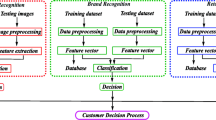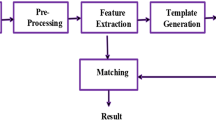Abstract
In this paper, we propose a novel quality assessment of finger-vein images for quality control in the enrollment and authentication of a finger-vein verification system. First, a Radon transform based model is employed to assess the quality of a finger-vein grayscale image. Second, to assess the quality of a finger-vein binary image, we further proposed three evaluation functions to measure the connectivity, smoothness and reliability of the binary version of the finger-vein image. Finally, the scores from the finer-vein binary images are fused with these from finger-vein grayscale images to improve the performance. Experimental results show that our approach can effectively identify the low quality finger-vein images, which is also helpful in improving the performance of the finger-vein verification system. We also show that instead of choosing the images with the highest quality as the enrollment templates, using the templates with the mid-range quality would achieve better performance with respect to improvement of varication accuracy.















Similar content being viewed by others
References
Abdel-Mottaleb M, Mahoor M (2007) Application notes algorithms for assessing the quality of facial images. IEEE COMPUT INTELL M 2(2):10–17
Belcher C, Du Y (2008) A selective feature information approach for iris image-quality measure. IEEE T INF FOREN SEC 3:572–577
Chang C, Lin C. LIBSVM. Online. Available http://www.csie.ntu.edu.tw/cjlin/libsvm
Cheong W, Prahl SA, Welch AJ (1990) A review of the optical properties of biological tissues. IEEE J QUANTUM ELECT 26(12):2166–2185
Deans SR (1983) The radon transform and some of its applications. Krieger Publishing Company
Fan H, Ma J, Fan H, Lv Z (2016) Iterative quadtree decomposition based automatic selection of the seed point for ultrasound breast tumor images. Multimed Tools and Appl 1–13
Fronthaler H, Kollreider K, Bigun J, Fierrez J, Alonso-Fernandez F, Ortega-Garcia J, Gonzalez-Rodriguez J (2008) Fingerprint image-quality estimation and its application to multialgorithm verification. IEEE T INF FOREN SEC 3:331–338
Grother P, Tabassi E (2007) Performance of biometric quality measures. IEEE Trans Pattern Anal Mach Intell 29:531–543
Hadi Hadizadeh, Ivan V. Bajić (2016) Color Gaussian Jet Features For No-Reference Quality Assessment of Multiply-Distorted Images, IEEE Signal Processing Letters. 23 (12)
Hashimoto J (2006) Finger vein authentication technology and its future. in Symposium on VLSI Circuits 5–8
Huang B, Dai Y, Li R, Tang D, Li W (2010) Finger-vein authentication based on wide line detector and pattern normalization. ICPR 1269–1272
Jain A, Lin H, Bolle R (1997) On-line fingerprint verification. IEEE Trans Pattern Anal Mach Intell 19:302–314
Jiang X, Mandal B, Kot A (2008) Eigenfeature regularization and extraction in face recognition. IEEE Trans Pattern Anal Mach Intell 30:383–394
Kalka N, Zuo J, Schmid N (2010) Cukic, B. Estimating and fusing quality factors for iris biometric images. IEEE T SYST MAN CY A 40:509–524
Kumar A, Zhou Y (2012) Human identification using finger images. IEEE T IMAGE PROCESS 21:2228–2244
Lee EC, Park KR (2011) Image restoration of skin scattering and optical blurring for finger vein recognition. OPT LASER ENG 49(7):816–828
Lee S, Choi H, Choi Kim KJ (2008) Fingerprint-quality index using gradient components. IEEE T INF FOREN SEC 3:792–800
Li S, Kot A. C (2011) Attack using reconstructed fingerprint. WIFS 1–6
Li C, Sanchez RV, Zurita G, Cerrada M, Cabrera D, Vásquez RE (2015) Multimodal deep support vector classification with homologous features and its application to gearbox fault diagnosis. Neurocomputing 168:119–127
Li XL, Guo Q, Lu XQ (2016) Spatiotemporal statistics for video quality assessment. IEEE Trans Image Process 25(7):3329–3342
Liu Y, Yang J, Meng Q, Lv Z, Song Z, Gao Z (2016) Stereoscopic image quality assessment method based on binocular combination saliency model. Signal Process 125:237–248
Lv Z, Li H (2015) Imagining in-air interaction for hemiplegia sufferer. IEEE 2015 international conference on In Virtual rehabilitation proceedings (ICVR) 149–150
Lv Z, Tek A, Da Silva F, Empereur-Mot C, Chavent M, Baaden M (2013) Game on, science-how video game technology may help biologists tackle visualization challenges. PLoS One 8(3):e57990
Lv Z, Halawani A, Feng S, Li H, Réhman SU (2014) Multimodal hand and foot gesture interaction for handheld devices. ACM Transactions on Multimedia Computing, Communications, and Applications (TOMM), 11(1 s), 10
Miura N, Nagasaka A, Miyatake T (2007) Extraction of finger-vein patterns using maximum curvature points in image profiles. IEICE T INF SYST 90:1185–1194
Mulyono D, Jinn H. S. (2008) A study of finger vein biometric for personal identification. ISBAST 1–8
Nguyen DT, Park YH, Shin KY, Park KR (2013) New finger-vein recognition method based on image quality assessment. KSII Transactions on Internet and Information Systems (TIIS) 7:347–365
Peng J, Li Q, Niu X (2014). A Novel Finger Vein Image Quality Evaluation Method Based on Triangular Norm. IIH-MSP 239–242
Platt JC (1999) Probabilistic outputs for support vector machines and comparisons to regularized likelihood methods. In advances in large margin classifiers. MIT Press 10:61–74
Proenc a H (2011) Quality assessment of degraded iris images acquired in the visible wavelength. IEEE T INF FOREN SEC 6:82–95
Qin H.F. http://pan.baidu.com/disk/home
Shen L, Kot A, Koo W (2001) Quality measures of fingerprint images, in Audio Video-Based Person Authentication. 266–271
Wong Y, Chen S, Mau S, Sanderson C, Lovell B (2011) Patch-based probabilistic image quality assessment for face selection and improved video-based face recognition. CVPRW 74–81
Yang JF, Shi Y (2014) Towards finger-vein image restoration and enhancement for finger-vein recognition. INFORM SCIENCES 268:33–52
Yang L, Yang G, Yin Y, Xiao RY (2013) Finger vein image quality evaluation using support vector machines. Opt Eng 52:027003–027003
Yang J, Wang Y, Li B, Lu W, Meng Q, Lv Z, Gao Z (2016) Quality assessment metric of stereo images considering cyclopean integration and visual saliency. Inf Sci 37:251–268
Zhou Y, Kumar A (2011) Human identification using palm-vein images. IEEE T INF FOREN SEC 6:1259–1274
Acknowledgements
This work is supported by the National Natural Science Foundation of China(Grant No. 61402063), the Natural Science Foundation Project of Chongqing (Grant No. cstc2013kjrc-qnrc40013; Grant No.cstc2014jcyjA1316), and the Scientific Research Foundation of Chongqing Technology and Business University(Grant No. 1352019; Grant No.2013-56-04).
Author information
Authors and Affiliations
Corresponding author
Appendix
Appendix
As we have shown in Section 4, how the templates are chosen will have an impact on the performance of a finger vein recognition system (EER is different when the templates are manually or automatically selected). In this appendix, we carry out experiments on database A to analyze the impact of different template selection strategies on the performance of a finger-vein recognition system [25]. Note that the system security level is still assumed to be 0.01% as in Section 4.
Among the 20 finger-vein images of each of the 200 fingers in the testing database established in Section 4, we choose the image with the highest, mid and lowest quality scores as the template, respectively. The following two types of scores are defined as the mid quality score in our analysis.
-
1)
The 10th highest score among the scores of the 20 images.
-
2)
The closest score to the average score of the 20 images. For simplicity, these two types of scores are termed as Type 1 and Type 2 mid scores.
The ROCs of the finger-vein recognition system are shown in Fig. 16 under different template selection strategies, with the corresponding EER given in Table 6. For comparison, we also report the ROC of the system when the templates are manually selected, i.e., the image with the highest quality by human vision is selected as the template. Note that we use the same protocol for computing the FRR and FAR as in Section 4. It can be seen that the mid score selection strategy achieves the lowest EER, which is around 1% lower compared with using other template selection strategies including the manual selection. For Approach A, the templates with the Type 2 mid score works the best with EER = 5.55%. For Approach B, the lowest EER is 5.95% which is achieved by using the templates with the Type 1 mid score. Both approaches show that using Type 1 or Type 2 mid score selection strategy can achieve a lower EER than using other strategies (see Table 6). Thus, one should select the image with the mid-range quality as the template enrolled in the database. This may be explained by following fact. In general, the high quality finger-vein image contains more vein feature than middle quality image. Compared to match two middle quality images, matching high quality finger-vein mage with middle quality image may create more errors. Moreover, most of middle quality finger-vein images instead of high quality finger-vein image may be captured in a practical finger-vein capturing system. Therefore, the ERR increases when the finger-vein image with high quality is selected as template.
Rights and permissions
About this article
Cite this article
Qin, H., Chen, Z. & He, X. Finger-vein image quality evaluation based on the representation of grayscale and binary image. Multimed Tools Appl 77, 2505–2527 (2018). https://doi.org/10.1007/s11042-016-4317-y
Received:
Revised:
Accepted:
Published:
Issue Date:
DOI: https://doi.org/10.1007/s11042-016-4317-y





